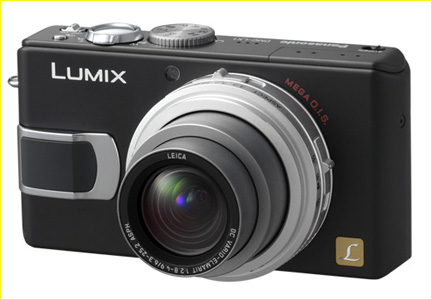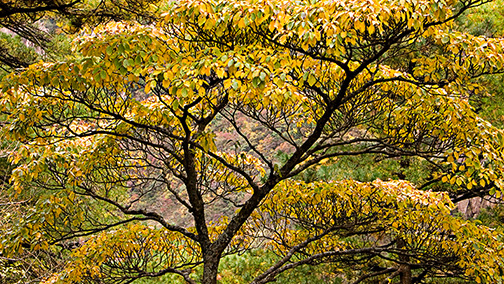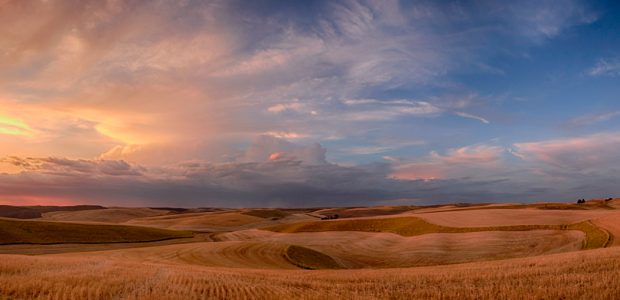
Photo Courtesy Panasonic
I don’t usually pay a lot of attention to digicams. They come and go from the market with alarming speed. There are seemingly hundreds of different models at different price points and with differing feature sets. But every now and then something unique comes along, and piques my curiosity. ThePanasonic LX1is one such camera, and the subject of this field report. (The Leica D-Lux 2 is essentially the same camera.)
This is best described as a field report because I no longer do formal camera or lens reviews. They’re tedious to do well, not much fun, and ultimately mind numbing in their repetitiveness. Also, there are people out there that do it much better then me. What I prefer to do is a field report – what the camera is like in actual use, what photographic challenge it’s best suited for, and what its strengths and weaknesses might be.
The LX1 came to my attention just a few days before I was to leave on a 2-week-long workshop which I would be leading in China in mid-October, 2005. After just a few minutes of close examination the Visa card came of one pocket and the LX1 went into the other.
My usual 30 pounds of gear for a major shoot consists of two full-frame Canon bodies, 5 lenses, tripod, flash units, and the rest. You can read about my kit for this triphere.
But I also travel with a pocket digicam as well as whatever more substantial gear may be in my kit. In addition to my professional photography for clients, books, portfolios, magazine articles and exhibitions, like everyone else, I also take snapshots. On a trip like this they may be of people and places that I simply want a record of, or when I’m taking a quiet walk, riding a bike, or out with friends and colleagues. In other words, when I don’t want to walk around with a heavy camera,just in caseI’ll take a digicam.
What caught my eye about the LX-1 is that in addition to being very small (much smaller than it looks in photographs), it has an 8.4 Megapixel CCD chip, and is the smallest digicam to shoot RAW. It is also the first digital camera to feature a true native 16:9 wide aspect ratio sensor, and – oh yes, it has optical image stabilization. The aspect ratio side of things requires a bit of explaining, so let’s jump right in.

Shanghai Dawn. China. October, 2005
Panasonic LX-1. ISO 80
_____________________________________________________________
16:9
A 16:9 aspect ratio means that the length of the frame to the width is 1.78 : 1. In other words for every unit of height, the width is 1.78 times wider. 16:9 is a way of describing this ratio without using fractions. Some would say it’s also more confusing.
But 16:9 is a standard; at least it is in the new world of high definition TV. In movies we are used to seeing wide screen films that are 2.35:1, and even higher.
In photography, 35mm film or full-frame digital is 3:2 (1.5:1), while many digital camera formats are a narrower 4:3 (1.33:1). So-called panoramic film cameras, such as the Hasselblad X-Pan and the Fuji GX617 are 3:1, which is as wide as it gets unless you’re doing Virtual Reality work, or using an antique banquet camera.
Frankly, I’ve always been a fan of wide aspect ratio images. But I’ve always found 35mm to be neither fish nor fowl; either slightly too wide or too narrow. The Xpan and the Fuji 617, both of which I’ve owned and used extensively in years past, were almost always too wide for my taste. But if I look at a lot of my work over the years, either 35mm or medium format cropped the way I want it, or Xpan or Fuji work reduced to a more palatable ratio, 16:9 seems to be about what I have ended up cropping to for much of my work. Maybe the fact that this is the aspect ratio for Hi-Def TV has something to it after all.
Now, let’s get back to the LX1.
Hangshan Vertical. China. October, 2005
Panasonic LX-1. ISO 80
_____________________________________________________________
In the Flesh
The LX-1 comes in both black and silver finish. In Canada, where I bought mine, it appears that only the black finish is available. I would have bought the black one in any event since I prefer cameras that are as unobtrusive as possible, rather than ones that appear like pieces of jewelry.
The business end of the LX-1 is aLeica DC Vario-Elmarit f/2/8-f/4.9lens equivalent in focal length to 28-112mm (in full-frame 35mm terms). This is an impressive piece of glass, both in aperture as well as range. Few pocket digicams offer a lens this wide, and fast, and sharp. The lens also, surprisingly, has optical image stabilization. This provides about 2 stops of additional hand-holdability, (and as will be seen, because of high ISO noise, it is needed).
On the top of lens is a detented sliding switch that offers 16:9, 3:2 and 4:3 aspect ratios. The LX-1 is a native 16:9 chipped camera, and to get the smaller ratios it crops the image. Interestingly, this cropping only is meaningful when shooting JPGs, because the RAW file always provides you with the full width of the image. Since when shooting in RAW mode the camera records both a RAW file as well as a JPG cropped to the format that you specify, you have the best of both worlds.
The rear LCD is bright and transreflective, clearly visible in most situation, including outdoors. There is no optical viewfinder, so this is a necessity. The LCD isn’t quite as visible as the best Sony transreflective screens in direct sunlight, but few screen are.
The rear has the usual multicontroler for accessing both frequent as well as less used functions. The all-important exposure compensation, as well as flash settings, are set this way, without having to wade through menus. There is a button that can be pressed to select AE lock and / or AF lock, and also instant review. I particularly appreciate the ability to superimpose grid lines for panoramic composition, and also an available real-time histogram.
Indeed there’s more, much more, and I could go on for pages listing all of the menu-based features and functions. If these are of interest to you prior to purchase, I can recommend thecomprehensive listingsonDPReview. Let it be enough here to note that this camera has all of the usual features, including magnified image review, movie mode, and really well executed manual exposure and focusing controls as well as the usual auto-everything.
_____________________________________________________________
The LX-1’s Achilles Heel
As a result of the conclusions published in a major online review, the LX1 has received a reputation as a "noisy" camera. Indeed it is noisier than some digicams of similar size and pixel count. But this isn’t the end of the story by any means.
Panasonic has a reputation of producing sensors and cameras that produce images which are not as silky smooth as those from some others. This is likely a consequence of less aggressive (or less sophisticated) noise reduction in camera. For those shooting JPGs this is a fact of life that will have to be lived with. And since pocket digicams are usually used in JPG mode, one has to accept this and make a choice. But since the LX-1 can shoot in RAW mode the photographer can apply appropriate noise reduction strategies in post processing, in which case the LX1 doesn’t suffer anywhere near as much as it does by comparison with its peers when shooting JPG.
My evaluation is that even without any aggressive NR efforts, the LX1 is perfectly acceptable noise-wise at ISO 80 and 100. ISO 200 needs help, and ISO 400 is frankly unacceptable without processing by a program such asNoise Ninja. Fortunately the noise is primarily chroma, so it cleans up quite nicely.
So, while the good news is that shooting in RAW mode allows the LX-1 to perform at its best, the RAW software provided by Panasonic is simply dreadful.Fugedaboutit. Fortunately the latest version ofAdobe’s Camera Rawfor bothPhotoshop CS2andElements 4already supports the LX-1, and does so very well. Combine the LX1 in RAW mode with Camera Raw, and the image quality will more than please you. JPG files, or RAW files processed with Panasonic’sPhotoFunStudiomay disappoint.

Yellow Mountains. China. October, 2005
Panasonic LX-1. ISO 80
_____________________________________________________________
Conclusion
I really like the Panasonic LX-1. To have a shirt-pocket-sized camera with a high quality Leica lens, optical image stabilization, wide-aspect ratio 8.4MP chip, and decent manual handling, is a pleasure. Anyone coming from a DSLR will find that the shooting is slower, and the need to use the LCD for composition and focusing less then ideal (though typical of digicams). But then there aren’t that many DSLRs with 4:1 zoom lenses that will fit in a shirt pocket, so the argument is moot.
If you’re looking for a serious camera of this size, that requires you to expend some additional effort in post processing, yet rewards with portfolio grade image quality, the Panasonic LX-1will not disappoint.
November, 2005
_____________________________________________________________
Anyone owning a Panasonic LX-1 or Leica D-Lux 2 may find theDNG Recover Edgesprogram to be of interest.
_____________________________________________________________
You May Also Enjoy...
The Palouse 2018 Harvest Workshop
FacebookTweet The Palouse Harvest Tour, Two – Four Person Private Tours 2018 The Palouse Harvest Tour – Workshops One and Two (August 15th – 20th 2
Panasonic GX7 Review
ThePanasonic GX7is that company's latest Micro-Four-Thirds camera. While the Compact System Camera segment is apparently not doing well in North America in particular, manufacturers keep


